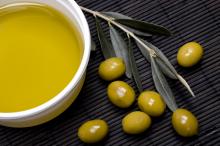Chew the Fat…Really!

This post is an installment in our 52 Health Hinges series. Remember, “Small hinges swing big doors.”
What if I told you that I knew of a food that would:
- Produce energy
- Provide the building blocks for your hormones
- Slow down the absorption of your meals so you can go longer without feeling hungry
- Help regulate blood sugar
- Feed friendly bacteria in your colon
- Inhibit the growth of fungi/yeasts like Candida
- Create thermogenesis, or heat, in the body and boost metabolism
- Boost your immunity
- Keep your arteries supple and your skin healthy
Would you eat more of this? YES, of course! So what is it? It’s fat!
What?
Believe it.
If you feel like I just told you that the sky is green, you – like me – must have grown up in the “low fat” era. I get it. I ate my fair share of low fat cookies and skim milk.
But here’s the deal – fat doesn’t make you fat. Sugar makes you fat. So if you’re fearful of fat and take measures to eliminate it from your diet, you not only miss out on the benefits stated above, but you’re also eating more sugar (taking the fat out of food removes its flavor – to make it taste good again, producers replace it with sugar).
Still not sure?
Our distrust of fat, especially saturated fat, goes back to the 1950s when scientist Dr. Ancel Keys created his “lipid hypothesis”, accusing saturated fats of raising cholesterol and causing heart attacks. At this time, heart disease was on the rise – even President Eisenhower suffered a heart attack – so Americans were hungry for answers, and Keys’ study appeared to provide the path forward.
However, we know now that Dr. Keys violated several scientific norms in his study in order to “prove” his beliefs, and the advice to go “low fat” is to blame for the obesity and diabetes epidemic.
Are you with me now? Good.
Now, to be clear, it is important that you know your fats and know how to use your fats.
Today, I’m going to introduce you to saturated fat, monounsaturated fat, polyunsaturated fat, and trans fat.
Saturated fat is fat that is typically solid at room temperature. Saturated fat was the target of Keys’ lipid hypothesis, and has spent the last 65 years being villainized. But fear no more. Good forms of saturated fat are butter, ghee, lard, and coconut and coconut oil.
When eating saturated fat, it’s important to find the best source possible. For example, try to find butter from grass-fed cows rather than conventionally-raised cows.
Finally, in case you’re still skeptical, let me share a quote from researchers George Mann, a professor of medicine and biochemistry at Vanderbilt University. He said, “The supposed connection between saturated fat and heart disease was the public health diversion of the century and the greatest scam in the history of medicine.”
Monounsaturated fats are oils – liquid at room temperature and solid when refrigerated. These fats are important heart protectors, they keep arteries supple, and skin healthy. Olives, olive oil, avocado, sesame oil, nuts, and seeds are a great way to get the monounsaturated oils into your diet.
Polyunsaturated fats include flax, hemp, pumpkin, walnuts, and their oils, and the very importantessential fatty acids that you’ve likely heard about. These are essential because the body cannot make them but they’re required for normal cell, tissue, gland, and organ function. Polyunsaturated fats remain liquid when refrigerated, and can easily become rancid or spoil. In addition, heating or cooking with them produces free radicals, which promote the onset of cancer.
Now that we’ve discussed the fats that heal, let’s touch on the fats that kill. Trans fats.
Most have heard about trans fats. Earlier this year, the FDA deemed trans fats as “no longer generally recognized as safe.” Good news, but unfortunately producers have been given a 3-year compliance period, so until June 2018, you still need to educate yourself to keep these out of your kitchens.
Trans fats, also called “partially hydrogenated oils” (PHOs), are artificially made and actually get stuck in our bodies, causing myriad problems. These are likely still found in many packaged foods. One more reason to cook at home using fresh ingredients!
So, fat is not the bad guy after all. In fact, incorporating more fat into your diet might help alleviate your aches and pains, help you shed extra pounds, and keep you full and happy.
[Click here for our guide on using fats and oils.]
More reading:
http://time.com/2863227/ending-the-war-on-fat/
http://time.com/3702058/dietary-guidelines-fat-wrong/
Comments
Eeating good fats helps to
Eeating good fats helps to keep you feeling full throughout the day, and as a result you will crave food less often and help your body break the cycle of carb addiction. Doctors preached that a low-fat diet is the key to managing cholesterol, losing weight and preventing health problems. But it is just not about the amount of fat, it’s the types of fat you eat that really matters. Bad fats increase your risk of certain diseases, while good fats support your heart and overall health.
nice post and thanks for
nice post and thanks for sharing.
Add comment